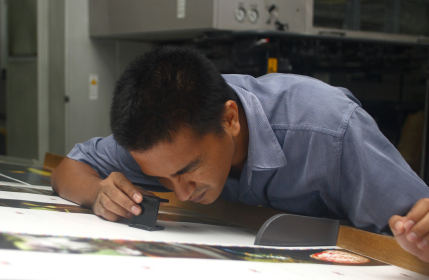Commercial Printing Tips
 Commercial printing screening – what is the difference?
Commercial printing screening – what is the difference?
FM vs. AM. we’re not talking radio here. What we’re talking about is Frequency. Modulation (FM) screening or stochastic printing and Amplitude Modulation (AM) or conventional screening. I know, it sounds like a mouthful, but if you’re a buyer of commercial printing, it’s a subject you should learn about.
In short, FM screening came to be as a by-product of Computer-To-Plate technology. It enables printers to print halftones or images differently than they do using the more traditional or conventional method known as AM screening.
Here’s a bit more detail on the subject.
The ABCs of FM and AM. screening
In stochastic printing or FM screening, halftones or images are printed using dots that are spread randomly throughout the image area. The dots are not equally spaced, nor are they lined up in grids or in rows. In this method of screening, the dots vary according to the tonal value that is to be reproduced. What that means is the lighter areas have fewer dots, while the darker areas have more.
On the other hand, in conventional printing or AM screening, halftones or images are printed using grid-like screens that separate the image into evenly spaced dots that are smaller in size in the lighter areas and larger in size in the darker areas. It’s also important to note that if the job is being done using four-color process printing, then separate screens need to be created to reproduce each of the four colors— black, cyan, magenta and yellow.
There are a number of advantages and disadvantages to both methods.
Since both methods of screening are still being used today, it’s important for you—the buyer of commercial printing—to know the advantages and disadvantages of each so you can make the most informed decision as to which one to choose for your next printing project. Here are some things to consider—
Commercial Printing with stochastic screening offers these advantages:
- Improved detail and definition
- Less ink on the sheet
- Elimination of moiré or rosette patterns
- Increased tonal values
- Improved highlight and shadow detail
- Crisper fine lines and small type
- Reversed text prints cleaner, and
- Wider color gamut
FM screening also produces much higher resolutions than AM screening methods. For example, a typical 20 micron FM screen would be somewhat similar to a 365 line AM screen, which is more than twice the screen resolution of a standard 175 line AM screen used on most offset presses.
Commercial Printing with conventional screening offers these advantages:
- Greater latitude of changing color density on press
- More forgiving halftone reproduction
- Better printing of large amounts of ink on paper, and
- Better production of one and two color printing
It may seem that there are more advantages to FM screening, but conventional screening is far from dead. On the contrary. There are instances when conventional screening should be used. For example, when higher line screens of 175 to 200 are used in halftones, and in four-color process printing.
Now you know the some of the ins and outs of commercial printing with FM and AM
Hope this short blog provided a clearer picture of the differences between commercial printing FM and AM screening. With this knowledge you can better make sure that the halftones or images on your next printing project are as good as they can be.
Have a great day…
Audrey Ferrante
Ferrante & Associates, Inc.
 Let’s connect
Let’s connect
If you’d like to learn more about how we think here at Ferrante & Associates, subscribe to our blogs or our monthly Newsletter Ferrante Speaks. You may also follow us on Twitter, Google+ or Facebook.
Don’t miss out: Subscribe and receive regular updates delivered automatically via a web portal, newsreader or email.







